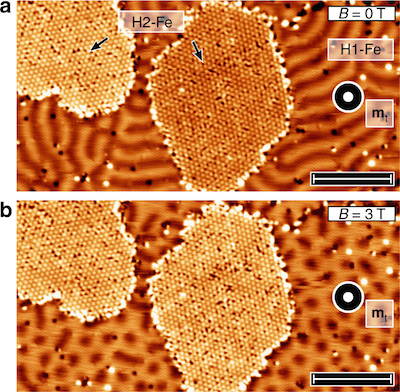Lendület Grant for Balázs Dóra
2018. May 23.
Balázs Dóra was awarded the prestigious grant from the Hungarian Academy of Sciences to establish a research group at the Department of Theoretical Physics.


2018. May 23.
Balázs Dóra was awarded the prestigious grant from the Hungarian Academy of Sciences to establish a research group at the Department of Theoretical Physics.

2018. May 11.
Professor of our institute received the award at the annual meeting of the Hungarian Academy of Sciences.

2018. May 09.
Hungarian state TV's report on the outreach event "Physics for Everyone" can be downloaded here.

2018. May 08.
New way of stabilizing surface magnetic skyrmions: publication in Nature Communications
Surface magnetic skyrmions (topologically protected magnetic whirls) are particularly promising elements of the next generation of high-density magnetic storage and magnetic logic devices. Researchers of the University of Hamburg, in collaboration with members of the Computational Magnetism research group of the Department of Theoretical Physics at BME, proposed a new method of stabilizing magnetic skyrmions, and published their results in Nature Communications. The atomic thin film Fe2/Ir(111) under investigation has a spin spiral ground state with a period of 1.2 nm and shows no formation of magnetic skyrmions in magnetic fields under laboratory conditions. Upon adsorption of hydrogen, a spin spiral ground state with a period of 3.5 nm was observed, from which stable magnetic skyrmions have been formed in the presence of an external magnetic field of 3 T, as shown by spin-polarized scanning tunneling microscopy (SP-STM) images. Former members of our institute, Levente Rózsa (presently staying in Hamburg with a Humboldt fellowship) and Krisztián Palotás (Slovak Academy of Sciences, Bratislava), as well as current coworkers of our institute, László Udvardi and László Szunyogh, participated in the research, and in terms of ab initio calculations and spin dynamics simulations revealed that the observed modulation of the magnetic ground state of the Fe layer upon hydrogen adsorption can be associated unambiguously with changes in the geometric and electronic structure of the system.
The publication:
Pin-Jui Hsu, Levente Rózsa, Aurore Finco, Lorenz Schmidt, Krisztián Palotás, Elena Vedmedenko, László Udvardi, László Szunyogh, André Kubetzka, Kirsten von Bergmann & Roland Wiesendanger
Inducing skyrmions in ultrathin Fe films by hydrogen exposure
Nature Communications 9, 1571 (2018).
Below: SP-STM images showing the formation of magnetic skyrmions in the ultrathin film Fe2/Ir(111) due to adsorption of hydrogen and magnetic field.


2018. April 29.
Papers of our colleauges were awarded two publication prizes of our university, "BME Outstanding Scientific Publication 2013-2017" and "BME Most Significant Scientific Publication in 2017".
BME Outstanding Scientific Publication 2013-2017
The authors are members of the MTA-BME "Lendület" Statistical Field Theory Research Group and the MTA-BME "Lendület" Exotic Quantum Phases Research Group.
B. Pozsgay, M. Mestyán, M. A. Werner, M. Kormos, G. Zaránd, and G. Takács
Correlations after Quantum Quenches in the XXZ Spin Chain: Failure of the Generalized Gibbs Ensemble
Physical Review Letters 113, 117203 (2014)
BME Most Significant Scientific Publication 2017
The authors are members of the MTA-BME "Lendület" Spintronics Research Group.
L. Szolnoki, A. Kiss, B. Dóra, and F. Simon
Spin-relaxation time in materials with broken inversion symmetry and large spin-orbit coupling
Scientific Reports 7, 9949 (2017)

2018. April 04.
BME takes part in popularizing physics in Lágymányos. The event starts at 10am, April 21.
The joint BME-ELTE programme in Lágymányos (in Hungarian): https://www.facebook.com/events/106993150118627/
Webpage of "Physics for Everyone" (in Hungarian): http://afizikamindenkie.kfki.hu

2018. February 27.

2018. February 05.
Hungarian consortium on quantum technologies, involving BME's researchers, holds a kick-off press conference on Feb 7 at the Hungarian Academy of Sciences.

2018. January 24.
BME's "MateFizika" lecture series on physics, with maths and experiments, starts on February 16.

2017. December 15.
Dr. Pál Gábor Koppa, head of the Department of Atomic Physics, was awarded for his contributions in optics research.
Source: http://www.gabordenes.hu/gabor-denes-dij-2017-sajtoanyag/
